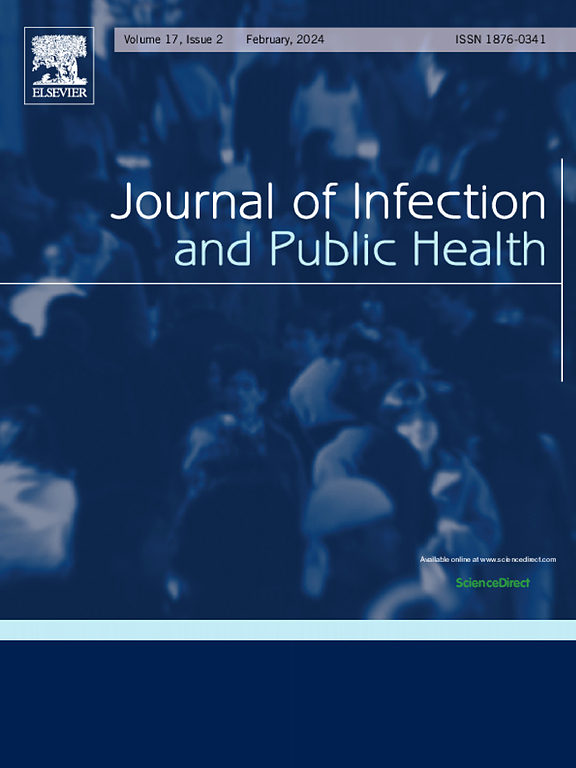Early fungal colonization and infection as an independent predictor of in-hospital mortality in mechanically ventilated COVID-19 patients: A nationwide target trial emulation study in Taiwan
IF 4.7
3区 医学
Q1 INFECTIOUS DISEASES
引用次数: 0
Abstract
Purpose
To evaluate the impact of fungal colonization and infection phenotypes and other prognostic factors on in-hospital mortality among mechanically ventilated COVID-19 patients (n = 376) admitted to ICUs during the first wave of the pandemic in Taiwan.
Materials and methods
A target trial emulation framework was used to minimize immortal time bias. Patients were matched 1:1:2 for age and gender and classified into three groups: 94 in the “Early” group (fungal colonization or infection within 10 days), 94 in the “Late” group (10–30 days), and 188 in the “No” group (no fungal colonization or infection within 30 days). In-hospital mortality and clinical outcomes were compared across groups.
Results
Patients in the “Early” group received higher cumulative corticosteroid doses, had lower PaO2/FiO2 ratios, and exhibited higher rates of comorbidities, cytomegalovirus viremia, and lung, heart, and kidney complications. They also had a longer duration of ventilator use, ICU stay, and total hospitalization compared to the “Late” and “No” groups. Time-dependent multivariate Cox regression analysis identified the “Early” phenotype as a strong predictor of in-hospital mortality (adjusted hazard ratio [aHR]= 3.992, 95 % CI: 2.676–5.956, p < 0.001). Additional independent risk factors included Charlson Comorbidity Index (aHR = 1.213, 95 % CI: 1.113–1.323, p < 0.001) and APACHE II score (aHR = 1.028, 95 % CI: 1.011–1.045, p = 0.001). In contrast, higher PaO2/FiO2 ratios (aHR = 0.998, 95 % CI: 0.997–1.000, p = 0.021) and ganciclovir use (aHR = 0.419, 95 % CI: 0.245–0.717, p = 0.002) were associated with reduced mortality.
Conclusions
“Early” fungal colonization and infection within 10 days of corticosteroid initiation is an independent risk factor for in-hospital mortality in mechanically ventilated COVID-19 patients. Future research should explore early intervention strategies, including antifungal prophylaxis, optimized corticosteroid dosing, and immune modulation, to improve survival outcomes.
早期真菌定植和感染是 COVID-19 机械通气患者院内死亡率的独立预测因素:台湾全国性目标试验模拟研究
目的评估台湾第一波大流行期间入住重症监护病房的COVID-19机械通气患者(n = 376)的真菌定植和感染表型及其他预后因素对院内死亡率的影响。患者的年龄和性别按 1:1:2 匹配,并分为三组:"早期 "组(10 天内有真菌定植或感染)94 人,"晚期 "组(10-30 天)94 人,"无 "组(30 天内无真菌定植或感染)188 人。结果 "早期 "组患者接受的皮质类固醇累积剂量更高,PaO2/FiO2 比值更低,合并症、巨细胞病毒感染、肺部、心脏和肾脏并发症的发生率更高。与 "晚 "组和 "无 "组相比,他们使用呼吸机、入住重症监护室和总住院时间也更长。时间依赖性多变量 Cox 回归分析发现,"早期 "表型是院内死亡率的有力预测因素(调整后危险比 [aHR]= 3.992,95 % CI:2.676-5.956,p < 0.001)。其他独立风险因素包括 Charlson 生病指数(aHR = 1.213,95 % CI:1.113-1.323,p < 0.001)和 APACHE II 评分(aHR = 1.028,95 % CI:1.011-1.045,p = 0.001)。相比之下,较高的 PaO2/FiO2 比率(aHR = 0.998,95 % CI:0.997-1.000,p = 0.021)和更昔洛韦的使用(aHR = 0.419,95 % CI:0.245-0.717,p = 0.002)与死亡率降低相关。未来的研究应探索早期干预策略,包括抗真菌预防、优化皮质类固醇剂量和免疫调节,以改善生存结果。
本文章由计算机程序翻译,如有差异,请以英文原文为准。
求助全文
约1分钟内获得全文
求助全文
来源期刊

Journal of Infection and Public Health
PUBLIC, ENVIRONMENTAL & OCCUPATIONAL HEALTH -INFECTIOUS DISEASES
CiteScore
13.10
自引率
1.50%
发文量
203
审稿时长
96 days
期刊介绍:
The Journal of Infection and Public Health, first official journal of the Saudi Arabian Ministry of National Guard Health Affairs, King Saud Bin Abdulaziz University for Health Sciences and the Saudi Association for Public Health, aims to be the foremost scientific, peer-reviewed journal encompassing infection prevention and control, microbiology, infectious diseases, public health and the application of healthcare epidemiology to the evaluation of health outcomes. The point of view of the journal is that infection and public health are closely intertwined and that advances in one area will have positive consequences on the other.
The journal will be useful to all health professionals who are partners in the management of patients with communicable diseases, keeping them up to date. The journal is proud to have an international and diverse editorial board that will assist and facilitate the publication of articles that reflect a global view on infection control and public health, as well as emphasizing our focus on supporting the needs of public health practitioners.
It is our aim to improve healthcare by reducing risk of infection and related adverse outcomes by critical review, selection, and dissemination of new and relevant information in the field of infection control, public health and infectious diseases in all healthcare settings and the community.
 求助内容:
求助内容: 应助结果提醒方式:
应助结果提醒方式:


